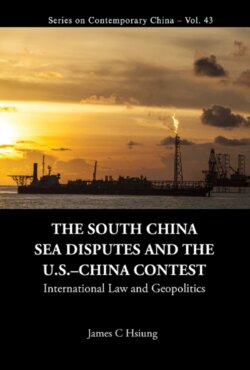Читать книгу South China Sea Disputes And The Us-china Contest, The: International Law And Geopolitics - James Chieh Hsiung - Страница 12
На сайте Литреса книга снята с продажи.
China’s Connections: An Inherent Link to a Historic Waters Claim
ОглавлениеAfter waiting out a period of hesitancy in the face of the Vietnamese and Philippine challenges, noted earlier, China’s National People’s Congress (NPC) passed a “Law on Territorial Waters and Adjacent Regions” in 1992. The Law formalized the People’s Republic’s 1958 “Proclamation on the Territorial Sea.” I wish to stress that for a true understanding of their legal and practical significance, these two documents must be read in the light of a map made by the Chinese in 1947, two years after the end of World War II (WWII), from which China under the Chiang Kai-shek government emerged as a victor power, on the side of the Western WWII Allies.
While China’s claim to the SCS goes back to the pre-Christian era (more details in Chapter 2), the Japanese Imperial Army during WWII occupied the major island groups, including Paracels and Spratlys. Under the Cairo Declaration (November 1943) and the Potsdam Declaration (July 1945), however, the WWII Allies agreed on a demand for the soon-to-be-defeated Japan that it must surrender (and return) all territories it had pilfered (“stolen”) from their original owners. Hence, after the war, the Republic of China (ROC), under Chiang Kai-shek, recovered these islands from the Japanese in 1946, with the logistical (naval) support from its U.S. ally.15 After regaining control of the SCS, the ROC government in 1947 drew an 11-dash line map delineating the maritime extent of Chinese control of the waters (including the islands) of the SCS. The map was known as “Map of South China Sea Islands.”16 It followed a much earlier “Map of Chinese Islands in South China Sea” (Zhongguo nanhai daoyu tu), published by the ROC’s Land and Water Maps Inspection Committee in 1935.17 The 1947 map showed the extent of China’s historic title over most of the maritime region in the SCS, and in international law it would come under the concept of “historic waters” (see discussion in Chapters 2 and 3). See the following map:
It should be noted that this map, showing the Chinese U-shaped line, resembling a cow’s tongue, indicates that China does not claim the entire SCS, as alleged by almost every critic and accuser of China’s “assertive” claim. The space in between the U-shaped broken line and the putative coastlines of the surrounding states, such as today’s Vietnam, Malaysia, Brunei, and the Philippines, clearly manifests an allowance for the territorial seas that they may opt to claim (after they emerged from colonial rule).
Figure 1.1(Internet Photo)
Apparently, this relative self-restraint may have been a reason why the map did not draw any international objection at the time. Another reason was that “historic waters” was a concept accepted by the prevailing international law at the time.
It is noteworthy that the Chinese map was immediately adopted in the 1947 edition of the Rand McNally Map of China, as shown in Figure 1.2, suggesting instant international recognition.
Figure 1.2“China” is Shown Underneath the Paracel Islands in Parenthesis on the Map Made by Rand McNally in 1947. (Internet Photo)
After the Communists took power in China in 1949, the new People’s Republic of China (PRC) government adopted the 11-dash line but reduced it to nine, eliminating the two dashes most adjacent to the Gulf of Tonkin as a gesture of friendship toward Ho Chi Minh’s Vietnam. After evacuating to Taiwan after losing the civil war on the mainland, the ROC government (now resettled in Taiwan), nevertheless, continues its claim to the SCS as before, but used the coopted name of the 9-dash line (rather than the original 11-dash line), in support of its claim.18
As mentioned earlier, the Government in Beijing, on September 4, 1958, issued the Proclamation regarding the breath of China’s territorial sea, which extended 12 nautical miles seaward from the China coast. It stated that the rule applied to “all Chinese territories, including … the Dongsha islands [Pratas], the Xisha Islands [Paracels], the Zhongsha Islands [Macclesfield Bank], the Nansha Islands [Spratlys] …” (emphasis added). Ten days later, in an official note to Chinese Premier Zhou Enlai, the Vietnamese Prime Minister, Pham Van Dong, declared “the Government of the Democratic Republic of Vietnam recognizes and supports the declaration of the Government of the People’s Republic of China’s territorial sea made on September 4, 1958.” (Pham Van Dong’s letter written in Vietnamese, reproduced below.19)
Special attention should be paid to this 1958 documentary evidence, attesting to the official Vietnamese government’s explicit recognition that the “Chinese territories” included the Paracels, which is now claimed by Vietnam in competition. The obvious reason is a hidden struggle for the oil resources near the Paracel island group. The conflict surfaced in early 2014 when the Chinese moved its Ocean Oil 981 oil rig to the territorial waters of the Paracel island group, which even by the Vietnamese Premier Pham Van Dong document should be within China’s territory. In its wake, however, Vietnamese anti-Chinese protests boiled over, from mob rioting, ransacking, to torching of Chinese (and other Asian but mistaken to be Chinese) factories and companies in different parts of Vietnam. Among rampant reactions worldwide, the U.S. State Department sided with the Vietnamese and blamed the violence and carnage on Chinese “unilateral action [that] appears to be part of a broader pattern of Chinese behavior to advance its claim over disputed territory in a manner that undermines peace and stability in the region.”20
Figure 1.3
